Site Links
Howdy, Stranger!
It looks like you're new here. If you want to get involved, click one of these buttons!
Quick Links
Categories
Who's Online (0)
Center Channel Speakers
To start things off, I have some questions for the group to generate some discussion:
- What makes a good center channel from a measurable performance perspective?
- What trade-offs are acceptable in a center channel that are not acceptable in other speakers?
- Do you ever use your center channel for pure audio (non-TV related)?
- How do you feel about your AV receiver's built-in GEQ and its ability to be used for room correction?
Feel free to post your thoughts on any or all of the above in any order that comes to you.
I built a center channel relatively recently and shared it on the PE forum. I'll share some details on it again here because it is a baseline for my newest center channel design. I'm curious everyone's opinions on the above as I near crossover prototyping on my latest.
Cheers!
Greg
Comments
I am leaning towards a triaxial 6 X 9 for my center channel next once I finish smoking the VC on one of my last pair of JBL 939's - one of them smells bad now . . .
All- If a 2way, the xover must be 1kHz or lower if side by side. This is to improve off axis response, and also why the W-T/M-W, or a full range flanked by woofers works so well. I agree that it must match L/R for best results and do well with voice. I however do not think it needs to have very low bass extension. It helps to also have a couple dB of higher sensitivity than the L/R as well.
I don't currently use one and am in phantom mode, and when I have had, I never have used it for stereo mixes. No room correction here.
InDIYana Event Website
I just run 2+2 (surrounds in ceiling).
I rely on my front left and right to create the front images, run it in music mode (surrounds play very, very low for some back fill for music) and for movies the surrounds play at a higher level (and I believe the bass gets a bit of a bump as well).
That said, a center speaker needs to fully duplicate what is taken away from the left and right channels- ie the center source, which then needs to be dominate. Too often, imo, a center box is of limited range and not up to the challenge.
Re. #2, I agree - a toppled MTM is generally going to be adequate up to 30 degrees off-axis.
Cool.
For my baseline center channel I was really fixated on a vertical MT arrangement flanked by two woofers for the (more favorable) polar response. I also tried to make as slim a speaker as possible. That lead me to the truncated RS75 with the OT19 on top flanked by RS100s. The total height of this speaker was 4.875".
I thought this center channel fit below my TV nicely, and how it looked and integrated into the room and the décor was a very large evaluation factor- it influenced the design almost more than anything else.
It was difficult to find a small form-factor mid that could cross low enough for the polar response I wanted and also a tweeter that could take up so little space, be spaced close to the mid for a small C-C distance, and cross low enough that the C-C distance wasn't a huge issue.
I was of the opinion that for 3-channel listening only getting to 100Hz was okay and the sub could pick up the slack from there. I chose to vent the RS100s to lower their excursion prior to high-passing them to the sub with the AV receiver.
I thought performance turned out well, but it took some work to get there.
Here is the on-axis response with the reverse nulls overlaid:

I thought the distortion profile turned out pretty good too!
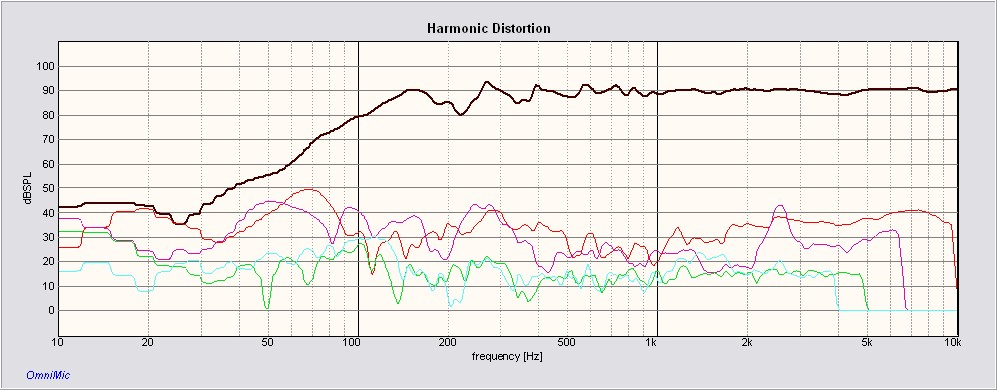
And all with only eight components:
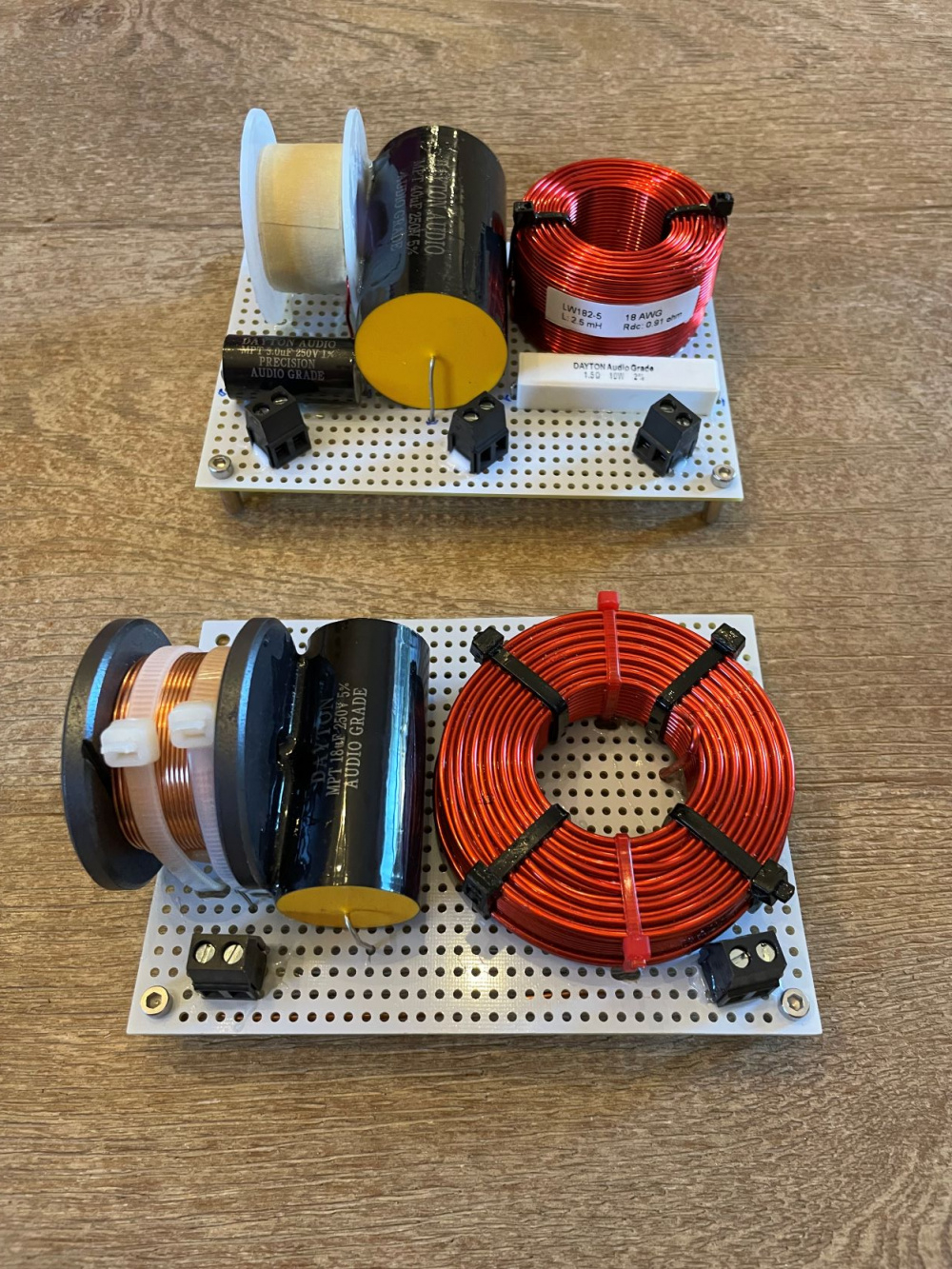
Crossover points were all second-order.
However, there were some serious flaws.
My first mistake was modeling each RS100 with a 1" vent and then using a 1.5" vent in construction like an idiot. The tuning was way high and peaking. It also coincided with a room mode peak and dip. I couldn't increase vent length to lower the tuning to where it was supposed to be because of how the port was oriented on the front of the baffle.
This exposed one of the other difficulties, which is room modes. My room exhibits a very large 10-15dB peak between 150-200Hz. I then have a dip right at 100Hz. This made it very difficult to integrate with the sub and also try to correct for my bone-headed tuning mistake.
But all this reveals my position on my AV receiver's GEQ, as that was the only way to massage the response into shape. The manual GEQ built into my receiver was limited - simple adjustments at 80, 160, 400, 1000, 2500. 6300, & 16kHz respectively, but it allowed me more flexibility than you might think.
Here is the raw response, room modes and all with no gating:
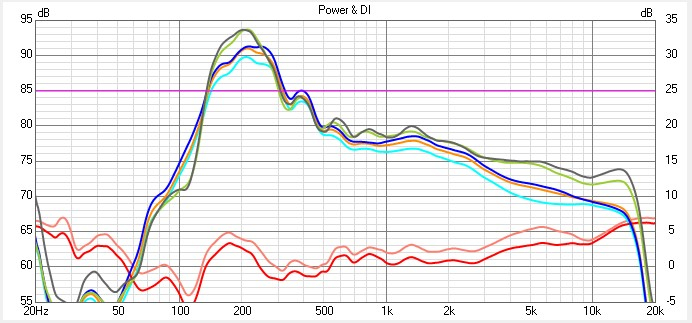
It was only through the GEQ that I was able to get to here:
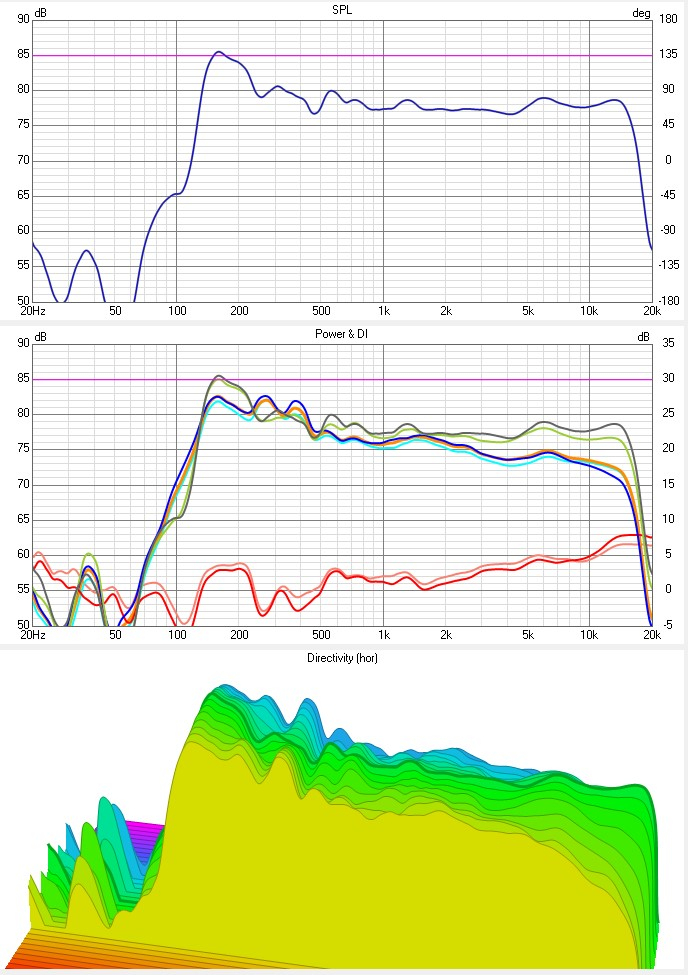
This response actually sounds pretty damn good!
I think I would have gone to PRs at that point. You have room on the baffle for 4x PRs, but likely 4 would again tune too high. 2x would likely be okay on xmax as you are highpassing the center anyway. The DSA115PR would likely tune low enough for you, and the holes are already there.
InDIYana Event Website
Not a bad idea.
I'm done with this one for now though.
The biggest problem with this initial center channel though was that it was too tall.
It was trapezoidal in shape, with the rear not being as tall as the front, but it still slightly blocked the bottom of the TV when viewed from the couch.
While developing it I had explored many, many midranges and tweeters of various sizes and so I knew there wasn't really any better option for a MT vertical arrangement that resulted in a shorter stack. So I knew I was going to have to go "fullrange" with no true tweeter.
I was okay with losing the very upper end performance since I only use my center channel for watching TV or movies (not music), so this was one of of the compromises alluded to in the first post that I was okay with. But what I wasn't okay with was crossing at 1kHz or higher and the resulting polar response being less than ideal. This means I needed a full range with good off-axis performance at the top end and low end oomph that allowed crossing low.
I heavily considered the PC68, and I thought it tested pretty well:
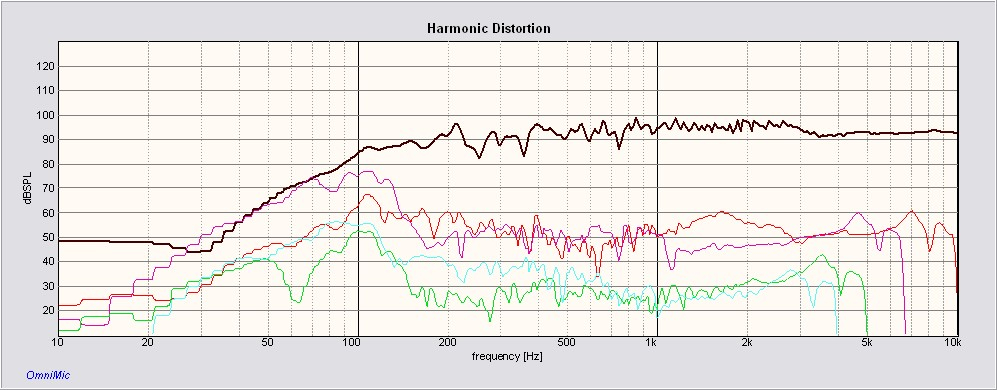
But I ended up getting the TA6 because Timothy Feleppa's data showed it had slightly better off-axis performance:
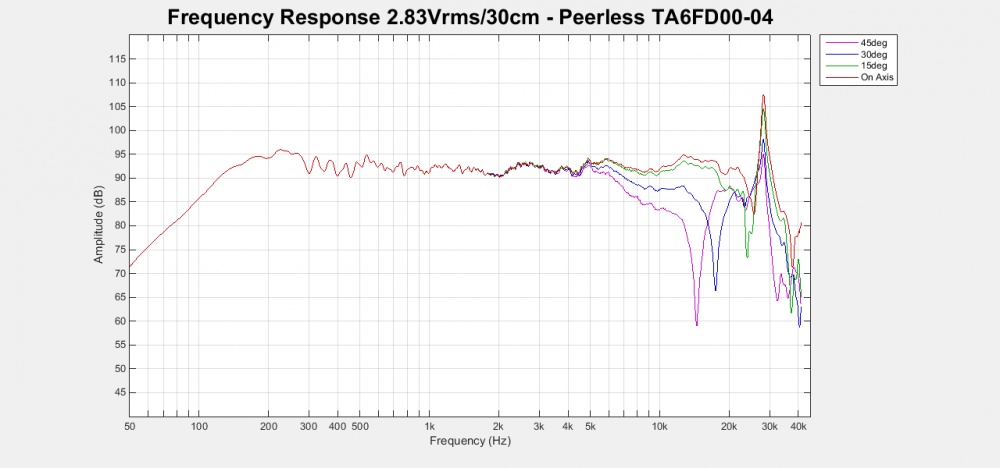
My own testing of the TA6 coincided with his:
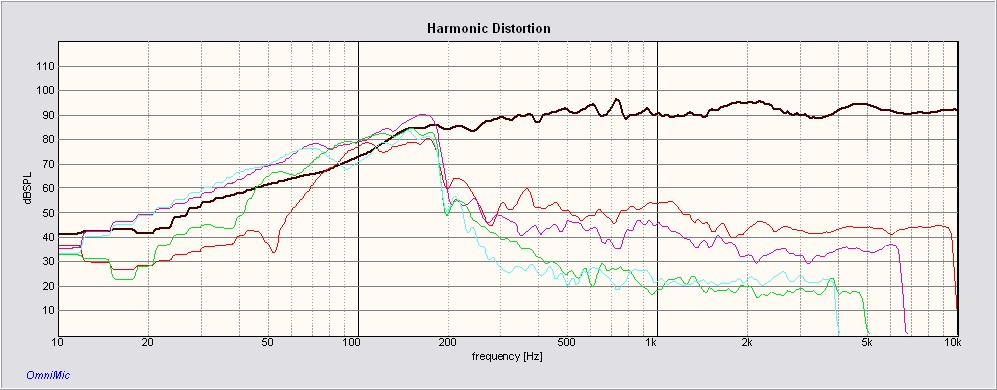
It's interesting to me to compare the off-axis performance of a large *edit "small" traditional tweeter with a small full-range.
*edit(These are 10 deg. measurement intervals)
Here is the OT19:
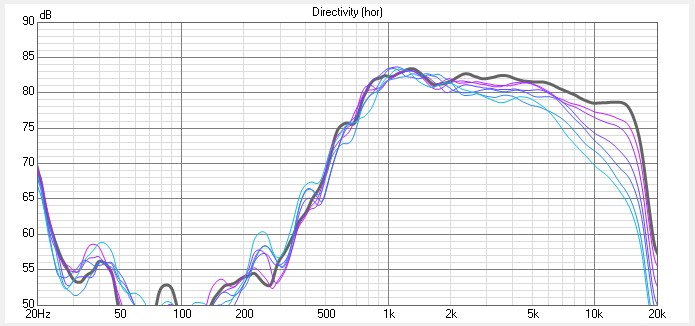
*edit these are 10 deg. increments up to 60 deg.
And here is the TA6:
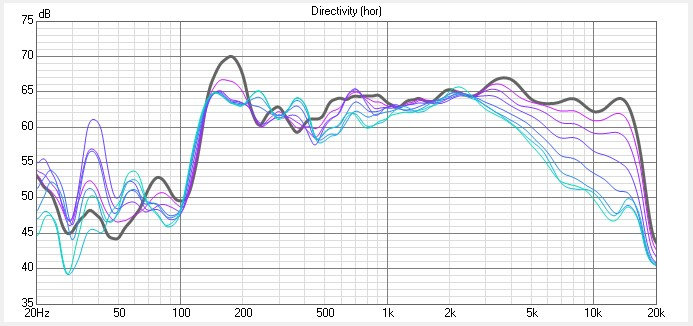
*edit these are 15 deg. increments up to 75 deg.
However the TA6 can cross at 400Hz...
Why not the little 2" Audible Physic from Newark?
InDIYana Event Website
How about using two Tectonic Elements TEBM46C20N-4B in the center to replace your "... vertical MT arrangement flanked by two woofers. . ." I have done extensive testing (and listening) with this driver and it seems to sound very good when used as a tweeter. It can be crossed quite low in a small enclosure, and has extremely smooth and wide horizontal polar plots. The only downside is the relatively low power handling, but if you use two of them vertically to replace both the RS75 and OT19, I would think that this would be a workable arrangement. And it is still fairly cheap; an amazing driver for the price!
https://www.parts-express.com/Tectonic-TEBM46C20N-4B-BMR-3-Full-Range-Speaker-4-297-2157?quantity=1
That is an excellent looking driver- I was not familiar with it.
Do you have experience with it?
Used it in my Bottleships design as a midrange. I did post individual driver measurements of it in the baffle too. Should tell you everything you would want to know.
InDIYana Event Website
https://diy.midwestaudio.club/discussion/2037/bottleships-in-progress-micro-3way-build/p1
InDIYana Event Website
I did look at this driver.
HiFiCompass has reviewed it, and I know it is the mid in the BMR Philharmonic Speakers, which is highly regarded.
I have to admit though, I'm a little turned off by the big dip shown in HiFiCompass' FR data at 10kHz. The TA6 is a bit smoother in that regard. And although it has a good distortion profile per HiFiCompass' review, it only extends down to about 1000Hz. In that sense it seems like it is a good mid, but inferior to the TA6 in my eyes as a true fullrange. I trust it does sound good though.
Power handling is an issue with any driver this size. Without getting into the actual dissipated power debate based on musical spectral content and crossover point though, as long as you cross over high enough to not run out of xmax, most of these little guys stand up okay. You just can't actually use them fullrange.
But I have already purchased and built with the TA6 in any case. I'll let the group know if I blow them up, lol.
So then on to the bass section: a daunting task to go down to 100Hz with a 2"-2.5" driver.
Going any larger would negate all the height benefit of selecting the TA6.
I'll just cut to the chase and just say I selected four (4) ND65-8 drivers, vented, but with the correct port size this time! The four of them model well to get down to below 100Hz before running out of xmax and achieving over 96 dB output levels.
The output bump of wiring them in parallel/series to get the 6dB boost also puts their 2.83V sensitivity right in line with the TA6. But would they do better than just fart at 100Hz?
One (1) couldn't even get me 96dB reference levels with my test amp because it was so insensitive, and it is clearly running out of xmax, resulting in the HD3 achieving unity with the fundamental level at 100Hz:
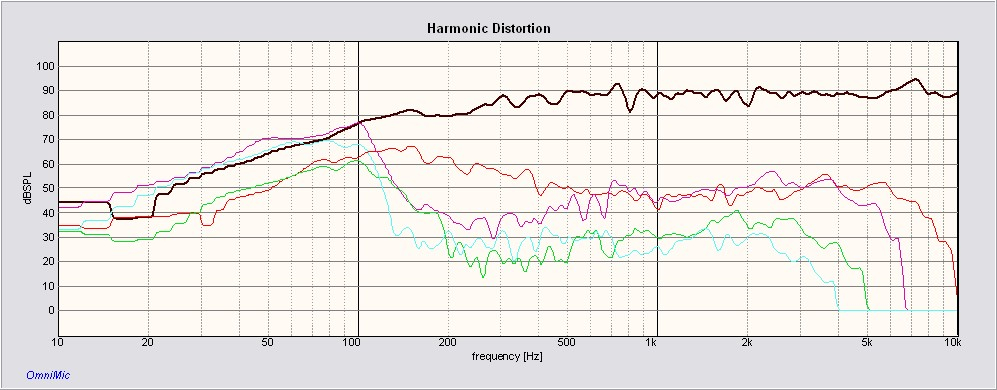
But four (4) of them!
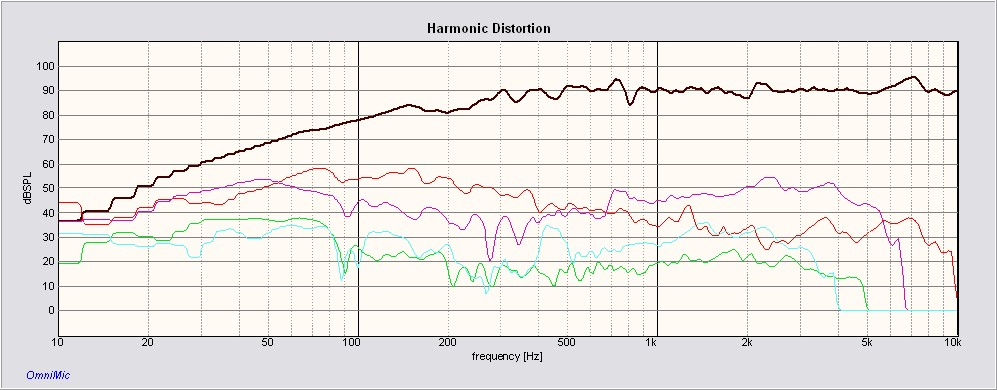
You can see how excursion related distortion drops dramatically for the same output level (90dB fund) (as shown above).
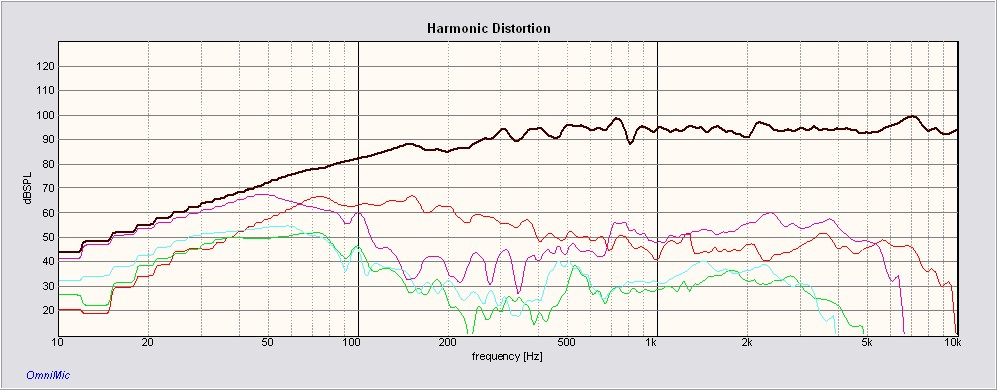
I could also then turn them up to the reference 96db fundamental so as to compare them to some of my other tests (shown below):
They're not quite as clean as the 2xRS100s in my first center channel, but they beat out a single TCP115 (shown below):
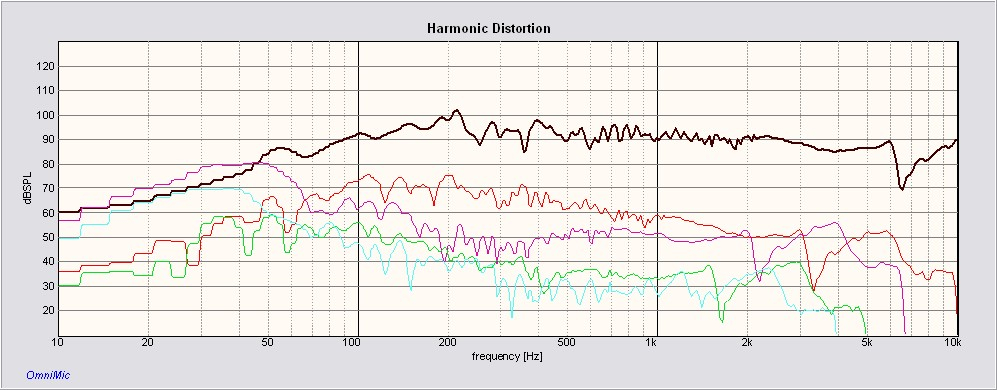
Build pics:
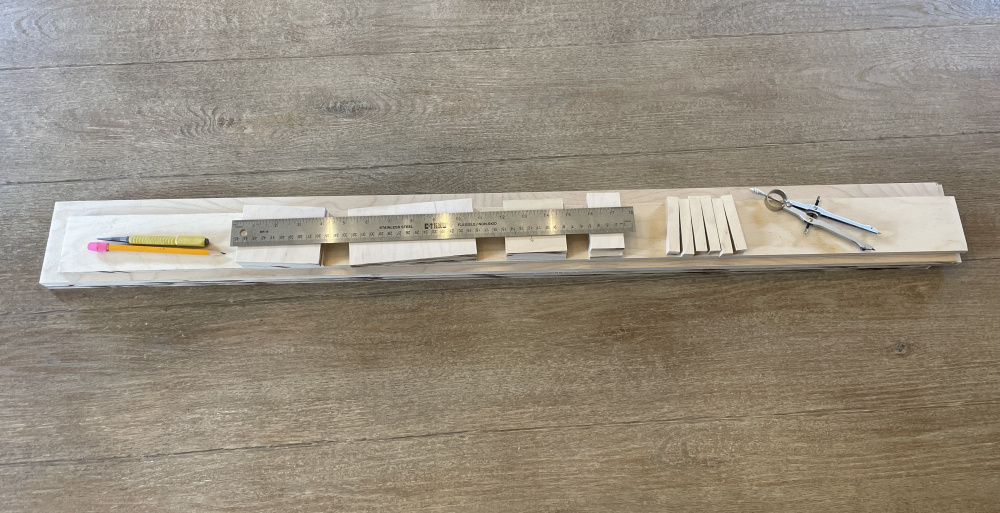
Not an ounce of wasted space, and only just enough room to fit the prospective crossover in there.
In the past I have been very outspoken on the use of cabinet damping and being smarter in our construction methods rather than just using 2" thick panels.
This is all 3/8" baltic birch. This speaker is only 3.5" tall.
Figuring out how to secure the crossover boards took some doing:
More:
I learned how to braid 5 strands , which was necessary because the crossover was to be split across the two sides:
, which was necessary because the crossover was to be split across the two sides:
Stuffing the TA6 chamber before putting on the top:
Looking great! I had no idea Amazon had their own damping material.
I didnt either.
A single SB/TB coax tweeter could still fit in a pinch if decided it's needed. They are tiny. Even coaxially in front on an arm. Billet mounted his coaxial tweeter to a steel grille.
In tight spaces I've always recommended a 1-screw xover mount. Usually this involves a 'card-slot' at the rear, and one screw to mount in the front. Remove screw and remove board. Other times like in my OSFA, I had as few cables venturing into the box as possible, and mounted most of the wiring, the drivers, and the xovers to the front baffle. Obviously, in this case the chambers interfere a bit, but removing the baffle screws alone to work on it could save time and be beneficial if the need arises to work on it.
I'm very interested in your outcome, Greg....
InDIYana Event Website
Excellent detail work in this project - almost like Swiss watch making . . .
I stumbled upon the amazon damping. It was the cheapest I could find. I'm sure the market is for car audio. I thought I was buying a sheet of the specified dimensions, but it was like 1o pieces, lol. It will last me many projects.
I also agree with the single screw and "card-slot" trick for crossover mounting. In the past I haven't been able to fabricate the receiver "card-slot" to tolerances that I'm happy with though.
I totally looked at a bunch of off-the-shelf coaxials! I couldn't find any small enough. Ben; which ones are you referring to? I also contemplated trying to make my own, but that's when I really asked myself what I was gaining: the TA6 is actually pretty good for the top end and I can lift it even further with my AV recevier's built in GEQ. Another driver and crossover for 5kHz and above just didn't seem worth it when my primary concern is being able to understand Christopher Nolan movies (dialogue).
I mean, look at the TA6 again:
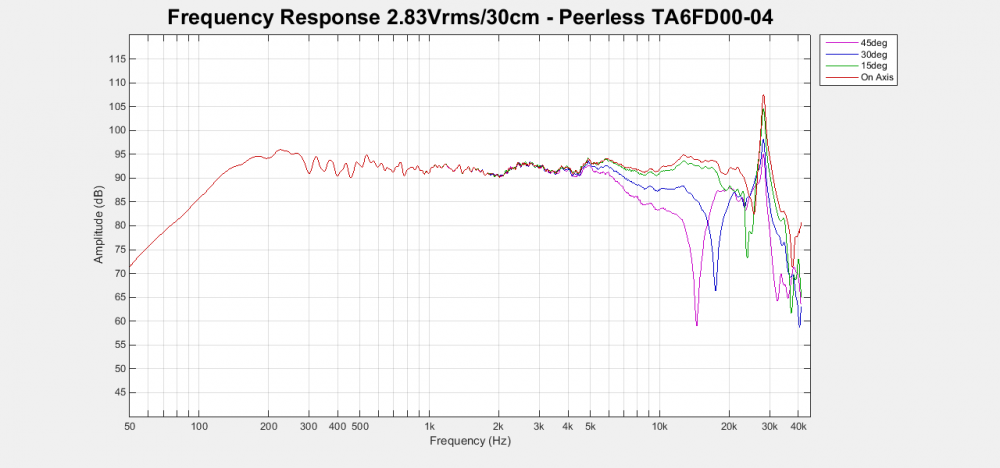
On the TA6, at 45 deg., the FR is down about 10dB at 10Khz.
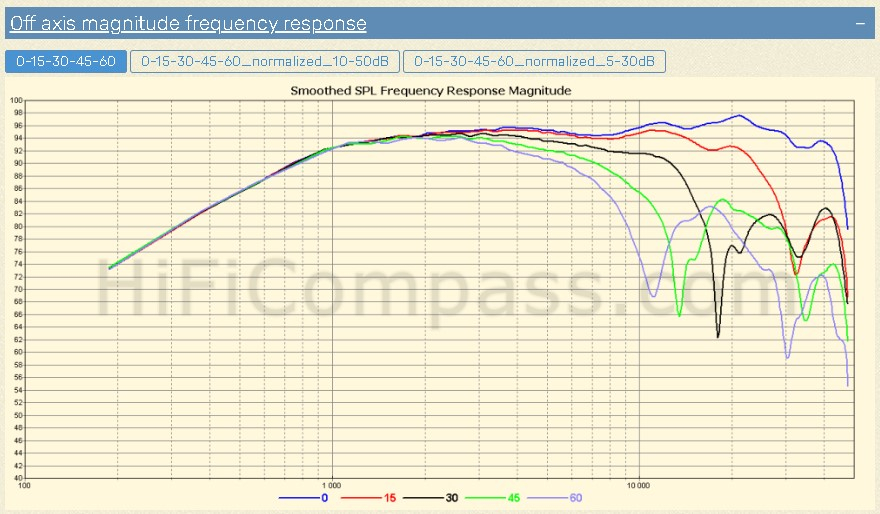
Compare that to the super-highly-regarded TW29RN-B which is also approximately 10 dB down at 10kHz!
Obligatory finished speaker in final location, sans crossover:
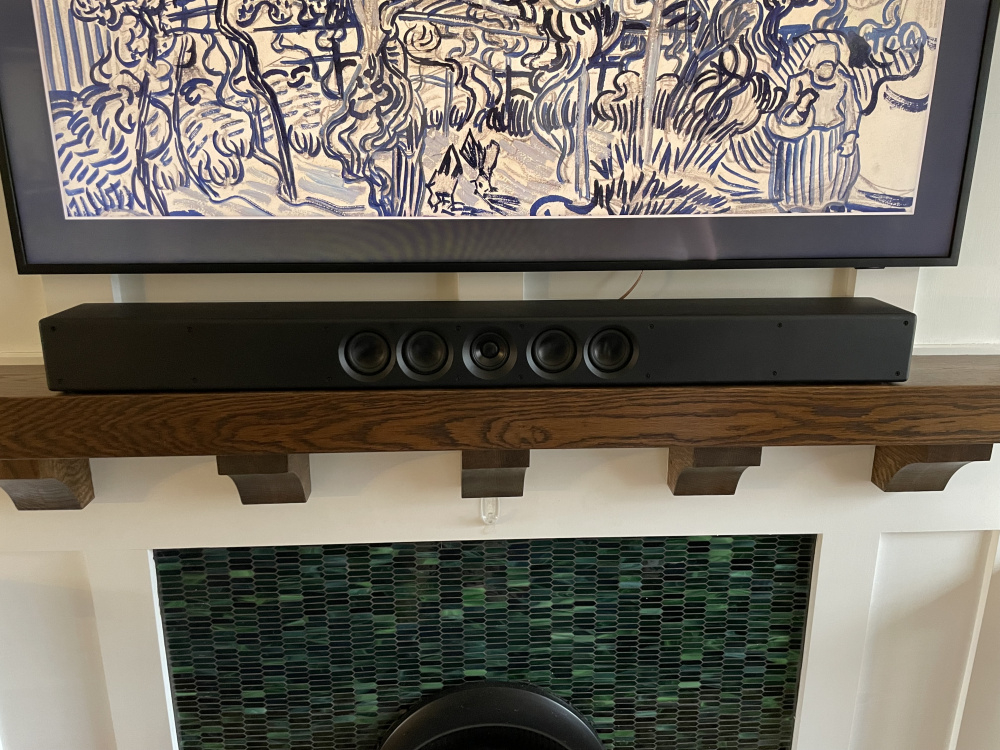
That looks great!
Looks nice under ‘The Frame’